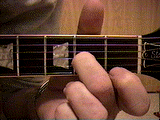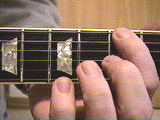Guitar Tablature Instruction: A six line staff that represents the guitar fretboard. When reading tablature, numbers indicate which string and notes are played. Each line equals the guitar strings.
 Illustration 2
Illustration 2
You do not have to use your middle finger, you can use your index finger if you like.
When you read tablature, each line equals each string on the guitar. Look above and notice each string and its placement.

Look at the the first tablature example above. This tab box above has the number 2 which represents the second fret, on the 3rd string. Play the 2nd fret G string Illustration 2 now. The note you just played is the A note.
Look below for another example of illustration 2. Each line in tablature represents each of the guitar strings. The numbers on each line or string is the fret number you play. So, the illustration below has the number 2 on the G string, this means to play the note at the 2nd fret G string. This would be the A note.
e-------------------skinny E string
B-------------------
G----2-------------play the note on the 2nd fret G string.
D-------------------
A-------------------
E-------------------Fat E string
The next illustration below shows a 12 on the first string E and a 12 on the second string B. Both of these notes are played together at the 12th fret E and B string. Play both of those notes together. These two notes are the E note and B note. Recall that I stated all notes repeat after 12 frets. Look below for an example of these two notes.
e-------12-----------skinny E, this is showing the note on the
12th fret.
B-------12------------this is showing the note on the 12th fret on the B
string.
G-------------------
D-------------------
A-------------------
E-------------------Fat E string
 The illustration to the left is the E major chord.
The illustration to the left is the E major chord.
Look below and notice how the E chord would be displayed in tablature. Since all the notes below are lined up on top of each other, they would be strummed together.
e -------0-------------skinny E string, 0 means leave open,
don't fret but strum.
B -------0-------------The 0 means leave open, don't fret, but strum.
G ------1--------------note on 1st fret, G string
D ------2------------- note on 2nd fret, D string
A ------2------------- note on 2nd fret, A string
E ------0--------------Fat E string, don't fret but strum.
Look below and notice how the A minor chord would look like in tablature.
e -------0-------------skinny E string, don't fret, but strum.
B -------1------------- note on the 1st fret, B string.
G ------2--------------note on 2nd fret, G string
D ------2------------- note on 2nd fret, D string
A ------0------------- don't fret, but strum.
E --------------------Fat E string, don't fret but strum.
To play the Am chord, the 1 finger is on the first fret B string. The 2 finger is on the second fret D string and the 3 finger is on the G string second fret. Play this chord and try not to touch the strings that are left open.
 |
 |
The next Illustration below is that famous A minor pentatonic scale again. This time it is shown in tablature and also in the Root Note Position 5th Fret. In the last lesson, I had you working on the A minor pentatonic scale with the fingers highlighted. This time in the image below, the frets are numbered on each string (or tab line). This is tablature and we will also be covering this subject more in detail later. I stated earlier that it is important to learn the fingering pattern system. The reason for this is because eventually we will only be showing the numbers representing the frets on the strings and not the fingers. You will eventually have the fingering for each scale memorized anyway.
Look at the image below and notice how it starts on the Low E string 5th fret. You would use the index finger to play the first note at the 5th fret. This would be the A note 5th fret, low E string. The numbers on each string (or tab line) represent the frets and strings being played. Look how the first note starts at the 5th fret, low E string and works its way through all the strings, then ends on the high E or 1st string 8th fret.The numbers below the strings are the fingers that play the notes through the scale.
 |
|


The illustration above shows the same A minor pentatonic scale in the root note position. The tablature indicates this scale being played.
Below is a sample lead using the Am pentatonic scale, root note fret position. Notice how it starts on the A note 7th fret D string, play this lead over the Am chord. The numbers under the lead are the suggested fingering pattern to use.

|
We still need to practice some finger exercises and understanding tablature will make the exercises that much easier to work on. Don't worry if you don't have the A minor pentatonic scale in the root note position memorized, we will be working on it again.
| We need to go over a few fingering exercises. |
Good Luck,
From the Jam Room

